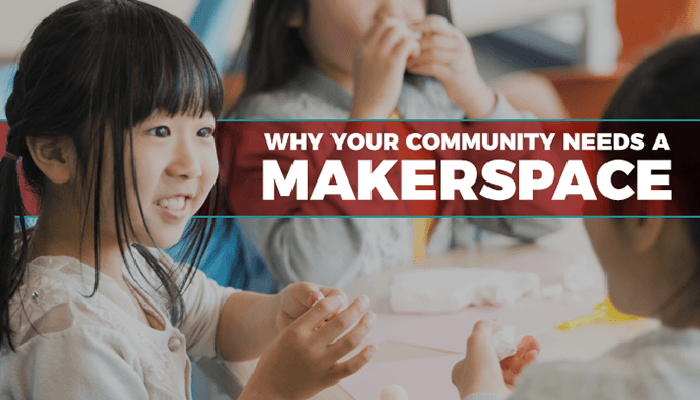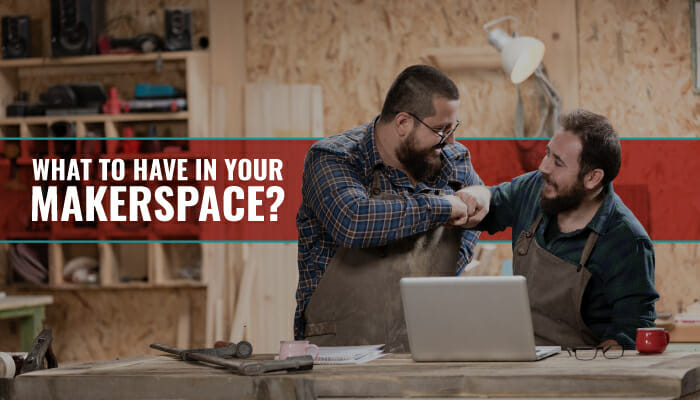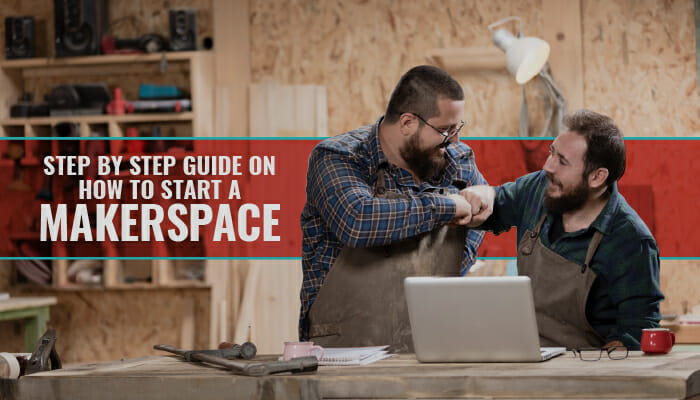What makes a strong community?
For us, we believe it’s when a group of people comes together to share ideas and build on them together for the benefit of all. A community is much more than a collection of individuals – it’s the spirit of togetherness and harmony that elevates people to something greater than themselves.
Makerspaces not only bring groups of people together, they create an environment where people are sharing ideas and literally “making” those ideas into a reality.
Why Your Community Needs A Makerspace
Today we’re going to discuss the ins and outs of makerspaces – what makes them special, how they work, and how they can benefit communities of all kinds. We also hope to inspire you to perhaps start one of your own.
What is a Makerspace?
At its core, a makerspace is about collaboration. While they can vary in the kinds of disciplines and topics that they cover, a fundamental truth about a makerspace is that it’s
a) open to the public
b) invites collaboration from everyone involved
c) works to create projects that benefit those it serves.
Simply put, a makerspace is a place where people can come together to learn and share ideas. Rather than trying to figure it out on their own, makerspaces enable people from all walks of life to get engaged in something about which they are passionate.
It is for that reason that we believe that makerspaces can enhance any community of which they are a part.
Alternate names for makerspaces include hackerspace, fablab, techshop, among others. For the most part, these names are interchangeable, but some of them refer to a specific kind of creation that happens in the space.
For example, a fablab might focus on engineering and building mechanical devices, while a hackerspace may be more open to interpretation.
Overall, they all mean the same thing, but that doesn’t mean that they all operate in the same way.
Crucial Elements of a Makerspace
While collaboration and the spirit of community are essential for any makerspace, there are a few other core elements that have to be involved for it to work.
What’s also important to remember is that there is no definitive ruling on what can or can’t be a makerspace. It’s less of a physical area and more of a mindset that encourages growth and creativity.
1. It Should be Educational
The Maker Movement started as a means of providing additional educational tools for students, and many makerspaces across the country are found inside of schools and universities.
However, that doesn’t mean that the idea is exclusive to them.
Libraries and community centers can also act as a foundation for a makerspace, but the fundamental element has to be that the space is designed for education.
While creative projects can serve as springboards for other initiatives (i.e., business startups or political movements), the foundation has to be in education.
2. It Has to Be Accessible
Makerspaces are open to anyone and everyone who wants to join. Those that are on school property are generally designed for kids attending, but makerspaces that are in the public domain should be accessible to all who wish to participate.
Accessibility means that the space itself should not be exclusive, even if certain programs or events have standards for enrollment (i.e., students 9-12th grade).
The idea of a makerspace is that it can be fluid in its uses, meaning that it should not be designed for one particular purpose.
Another thing to consider is accessibility for those with special needs. Because the spirit of a makerspace is open collaboration, those who are disabled shouldn’t be excluded as well.
As we’ll discuss when we talk about building a makerspace, you should consider people who have limited mobility when creating your design.
3. There Has to Be (Some) Structure
If you have a room where people just come together and do whatever they want, then it’s not really a makerspace. One of the fundamental aspects of these spaces is that they have to be focused on creating and building things while allowing for open collaboration.
A collection of individuals working on their own projects is more akin to a library or study room. A makerspace has to have some kind of structure in place to elevate it to the next level.
Having a set structure also helps motivate people to work together on projects. If everyone is working on different things at one time, you will find everyone trying to solve their own problem at the same time. Which often calls for an overwhelming situation for educators and students.
But don’t feel like you need to have traditional structure. When we say structure, we mean some type of set expectation. Tinkering or “playing around” with a device can fall under the term “structured” if it is planned for.
We suggest
- Having set classes with a flexible itinerary to follow
- Categorized times for set types of projects
- Using turnkey solutions like Creation Crate’s Classroom Kit
Structure can come from a few different sources. An excellent example is to have professionals or educators involved in the creative process to ensure that everyone stays organized and on task. Another option could be to create various curriculums based on specific ideas.
Classes are usually integral to the success of a makerspace, so having a guiding principle that helps shape the direction of the space can ensure that everyone stays on track.
4. It Has to Have Some Means for Success
Getting students into a room and having them collaborate on ideas is great, but if you have no means of making their ideas tangible and real, then it’s not really a “makerspace,” is it? The purpose is to make things, not talk about them.
How to Create a Makerspace From Scratch
Now that we know the elements that serve as the foundation for a makerspace, how do we go about creating one for ourselves? The process is relatively simple, although it can take a while to go from idea to execution. Here are some of the most crucial steps that you have to take when trying to create a new makerspace.
1. Find a Suitable Location
As we mentioned, many makerspaces live in schools as a means of augmenting student’s education. However, that doesn’t mean that you should limit yourself to classrooms or study halls.
Any kind of public space can work for a makerspace, but you want to be sure that it fits within the parameters you want to have.
For example, if you want your makerspace to be focused on STEM projects, then you want to make sure that it has sufficient space for building complex and sophisticated projects. Also, since you’ll likely need a lot of power, you have to be sure that you can get access to sufficient outlets.
Another example could be that your makerspace is dedicated to food science and cooking. As such, you have to find an area where people can prepare and cook different foods without causing any problems.
Overall, you should find a place that allows for the kind of collaboration and creation that you want to foster.
2. Find Professionals
Since structure is such a crucial element of a makerspace, you need to make sure that you have people who can help instruct those who attend. A class about mechanical engineering is not going to gain traction if you don’t have someone who is well-versed in the topic to teach it.
That being said, not everyone who leads a makerspace has to be an expert. As long as the person can provide the right kind of leadership and focus that will yield results, that’s what matters most.
A passion for creativity and learning is all that’s really required, although extensive knowledge about a subject will make things much easier for everyone involved.
This can include
- Teachers
- Librarians
- Parents
- Other Makers
- College Students
3. Find Equipment and Supplies
When first building your makerspace, you probably won’t have funding to buy all of the fancy gadgets and machinery you want. While a 3D printer will be helpful, they can be prohibitively expensive. Instead, focus on things that can help the creative process and trust that new equipment will come with time.
While there are no rules regarding what specifically has to be present in a makerspace, there has to be some collection of tools and components that can help turn ideas into reality.
Some makerspaces have 3D printers, while others have computer banks and bins of electronic parts.
If you don’t know what electronic parts to start with in your makerspace, we suggest reading “The Complete Tutorial List Of Breadboard Components” to see what typically is used for beginner electronic projects.
As long as the different pieces help those in the space achieve their goals, that’s what matters most. A makerspace can be either high or low-tech, as long as it provides a means for making and building things.
Another thing to consider is furniture. If your makerspace is utterly barren at first, then you’ll need desks and chairs. Consider asking for donations to fill the space at first and then go from there once you have a steady stream of attendees.
Need more resources? Check out our article “What To Have In Your Makerspace”
Community Benefits of Makerspaces
We’ve been talking about the abstract benefits of creating makerspaces, but what tangible results can you expect when you get yours off the ground? Here are a few benefits that we’re seeing with makerspaces all over the country.
1. Innovation
When you invite people and students from different backgrounds to work on a project, there is a lot more creativity involved than if it were being run by one or two individuals. Our ability to create is based on our own experiences – this means that if we have a limited background from which to draw, we can’t expand much further than that.
With diverse makerspaces, we can see all kinds of innovation that would otherwise be impossible to cultivate. It’s here that we can see ideas that can change the world.
2. Resource Sharing
When trying to get an idea off the ground, we are limited by our abilities and finances. However, when we invite others to collaborate, we have so much more capital at our fingertips. Even if the capital is not money, we have people who can help us reach our goals and develop our projects more easily. When people come together, anything is possible.
3. Problem-Solving
While educational makerspaces can help kids understand complex subjects, many public makerspaces are dedicated to providing social change that can have a more significant impact on the community. In these cases, the people who attend are driven to solve the problems facing the community so that everyone can thrive. Since they have access to more resources, they have a much higher chance of success. Everyone wins.
4. Working Together
Finally, another excellent benefit of having a makerspace in the community is that it shows the power of people working together to achieve a common goal. In modern society, individualism tends to be the main focus, but makerspaces help to break down barriers that separate us and allow us to be more open and sharing. When a community can work together, change is inevitable, and it brings a brighter future for all those involved.
Real-World Examples of Makerspaces
To help you get inspired, we want to showcase some of the makerspaces that exist around the country. In many cases, you may be able to find one in your community. However, if you don’t, then you already know how you can get one started.
As we’ve seen, great things happen in makerspaces, which is why we are so supportive of them. We encourage you to reach out and become a part of one today.
Genspace – New York

This makerspace is high-tech as it is a fully-functioning laboratory. The goal of Genspace is to bring science enthusiasts together to work on a variety of biotech projects. Classes in neuroscience and DNA barcoding are offered, among others. Whether you’re a beginner or an expert, Genspace caters to all.
TechShop – San Francisco
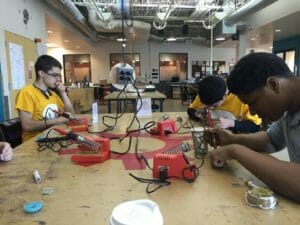
This is an example of a “fab lab” where people have access to a variety of tools and equipment that they can use to build a variety of engineering projects. In this case, members do have to pay a fee, but that’s because the machines are state-of-the-art.
NextFab – Philadelphia
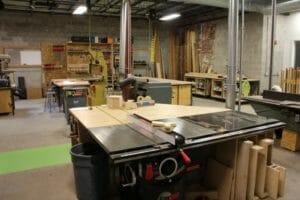
The goal of NextFab is to invigorate young minds in the world of manufacturing. Since this industry has been in steady decline in the area, the founder Dr. Evan Malone hopes to inspire a new generation to bring manufacturing stateside again. Not only does this makerspace offer educational resources, but it encourages attendees to learn how to turn their ideas into businesses.
